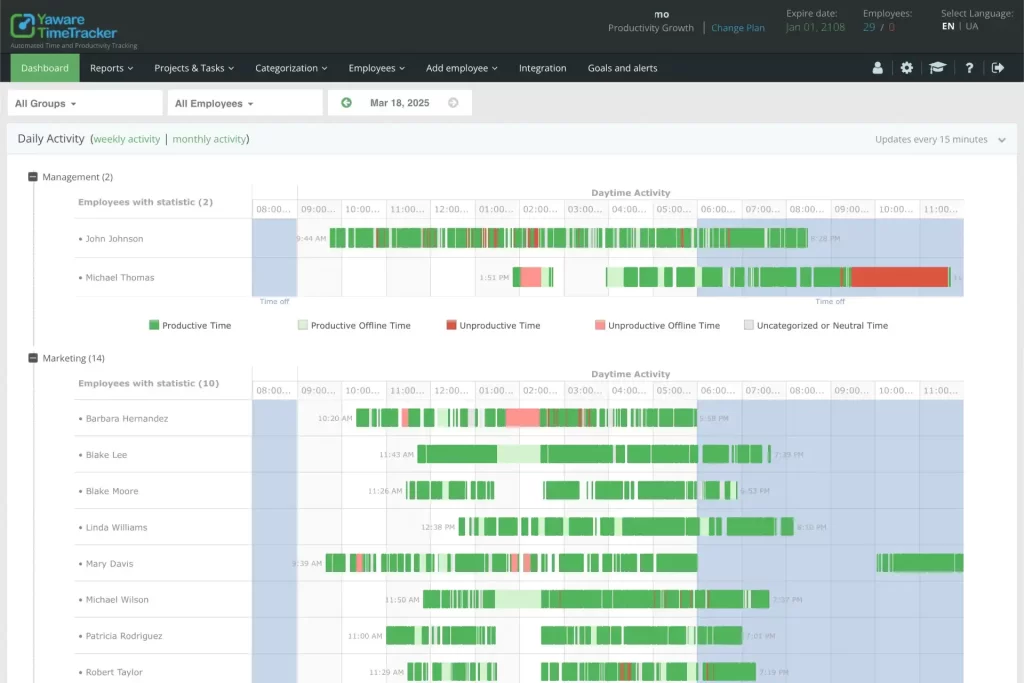Remote work fundamentally changed how teams connect and collaborate, but it also obscured many traditional indicators of employee engagement. Managers who once relied on office energy, casual conversations, and visible enthusiasm now struggle to identify when team members feel disconnected or unmotivated. This visibility gap creates serious risks for team cohesion and individual performance that many organizations discover too late.
Why employee engagement is harder to spot in remote teams
Physical distance eliminates the subtle cues that help managers gauge team morale and individual satisfaction. Body language, tone changes, and informal interactions provided valuable context for understanding how people felt about their work and workplace relationships. Remote employee engagement requires different observation methods because these natural feedback mechanisms disappear in distributed environments.
Recent studies show that trust between managers and team members declines 32% faster in remote settings when visibility is limited. Without regular check-ins and structured communication, small frustrations can escalate into serious disengagement before anyone notices the problem. The lag between actual engagement decline and visible performance impact often spans several weeks.
Remote environments also amplify the effects of unclear expectations, inadequate support, and insufficient recognition. Issues that might be resolved quickly through casual office conversations can fester when communication becomes more formal and scheduled.
What early signs suggest engagement is slipping?
Disengaged remote employees often exhibit behavioral changes before their work quality declines noticeably. Missed optional meetings, reduced participation in team discussions, and delayed responses to non-urgent communications can indicate growing disconnection from team goals and relationships.
Late task completion doesn't always signal workload issues—it might reflect diminished motivation or unclear priorities. Similarly, decreased initiative in suggesting improvements or volunteering for additional responsibilities often precedes more obvious performance problems. Signs of disengagement typically emerge as patterns rather than isolated incidents.

Communication changes provide particularly valuable insights. Team members who previously contributed regularly to discussions but become consistently quiet may be experiencing frustration, confusion, or loss of connection to their role. Monitoring these patterns helps identify engagement issues while they're still addressable through conversation and support.
What metrics help you track engagement without invading privacy?
Effective employee engagement tracking focuses on observable behaviors rather than invasive monitoring of personal activities. Communication frequency, voluntary participation in team events, and proactive problem-solving attempts provide insight into engagement levels without crossing privacy boundaries.
Monitoring engagement in remote teams works best through voluntary feedback mechanisms combined with passive behavioral indicators. Regular pulse surveys capture subjective experiences while activity patterns reveal objective changes in work approach and team interaction. The combination creates a comprehensive view without surveillance concerns.

Initiative rates offer particularly valuable engagement insights. Track how often team members suggest process improvements, volunteer for challenging projects, or help colleagues with their work. These voluntary behaviors correlate strongly with engagement levels and provide early warning when motivation begins declining.
Realistic strategies to maintain healthy engagement remotely
Sustaining team connection across distributed environments requires intentional strategies that address both professional development and social cohesion. These approaches work because they create multiple touchpoints for engagement while respecting individual work styles and personal boundaries.
Five proven methods to sustain engagement across distributed teams:
- Structured one-on-ones with open agendas – Regular individual conversations where team members drive discussion topics and share concerns freely
- Cross-functional project rotations – Opportunities to work with different colleagues and learn new skills outside primary responsibilities
- Virtual coffee chats and informal team events – Casual interaction opportunities that replicate spontaneous office conversations
- Transparent goal setting and progress sharing – Clear visibility into how individual work contributes to broader team and organizational objectives
- Recognition systems that highlight diverse contributions – Acknowledgment for collaboration, mentoring, innovation, and other valuable behaviors beyond task completion
These strategies work because they address multiple dimensions of engagement simultaneously: professional growth, social connection, purpose clarity, and individual recognition. Team engagement analytics consistently show higher retention and satisfaction rates in teams that implement several of these approaches consistently.
How to interpret drops in engagement — without jumping to conclusions
Engagement decline often reflects systemic issues rather than individual performance problems. Psychological safety concerns, unclear role expectations, or inadequate resources can cause motivated employees to appear disengaged when they're actually frustrated with circumstances beyond their control.
Burnout phases create temporary engagement dips that recover with appropriate support rather than performance pressure. Remote team motivation requires understanding these natural cycles and responding with resources rather than criticism. Recent research indicates that 67% of engagement issues resolve when managers address underlying obstacles rather than questioning individual commitment.
Disengagement can also signal silent resistance to poorly communicated changes or unrealistic expectations. When multiple team members show similar engagement patterns simultaneously, investigate organizational factors before focusing on individual conversations. Context matters more than metrics when interpreting engagement data.
Common mistakes when managing engagement remotely
Well-intentioned managers often undermine engagement through approaches that create anxiety rather than support. Understanding these counterproductive patterns helps leaders avoid common pitfalls that damage team relationships and reduce overall motivation.
Engagement-killing habits even well-meaning managers fall into:
- Over-scheduling check-ins and status meetings – Creating surveillance anxiety instead of providing supportive communication opportunities
- Treating engagement metrics as performance scores – Using behavioral indicators to evaluate individuals rather than understanding team dynamics
- Ignoring workload distribution patterns – Failing to notice when high performers consistently receive disproportionate task assignments
- Responding to engagement dips with increased monitoring – Adding oversight pressure when team members need more autonomy and trust
- Assuming engagement problems reflect personal issues – Missing organizational factors that affect multiple team members simultaneously
These mistakes occur when managers focus on control rather than support, creating environments where team members feel monitored rather than valued. Employee sentiment monitoring should enhance trust and communication, not replace them with measurement and evaluation.
What changes after implementing transparent engagement tracking
Organizations that approach engagement monitoring thoughtfully typically see improved communication patterns, increased voluntary feedback, and stronger team cohesion. Team members appreciate understanding how their contributions fit into broader objectives and feel more comfortable discussing challenges before they become serious problems.
The shift from assumption-based management to data-informed support creates psychological safety that encourages honest communication about workload, goals, and obstacles. Engagement metrics for remote teams become conversation starters rather than evaluation tools when implemented with transparency and team input.
Teams also report improved self-regulation and peer support when engagement patterns become visible. Colleagues can offer assistance when they notice teammates showing signs of stress or disconnection, creating a collaborative approach to maintaining team health and productivity.
Lately, more teams are choosing tools that help detect early signs of disengagement—without turning into surveillance. If you're curious how it looks in practice, register at Yaware.TimeTracker and see it live.

